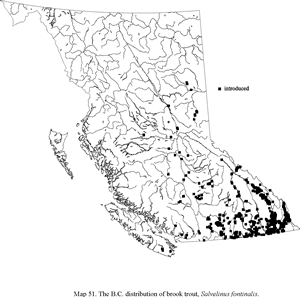Dorsal spines (total): 3 - 4; Dorsal soft rays (total): 8 - 14; Anal spines: 3 - 4; Anal soft rays: 8 - 14; Vertebrae: 58 - 62. Distinguished by the combination of dark green marbling on its back and dorsal fin and by the red spots with blue halos on its sides (Ref. 27547). Pelvic fins with axillary process; caudal nearly straight or with a shallow indentation (Ref. 27547). Color varies, but generally rather green to brownish on back, marked with paler vermiculations or marbling that extend onto the dorsal fin and sometimes the caudal; sides lighter than back, marked with numerous pale spots and some red spots, each of the latter surrounded by a blue halo; anal, pelvic and pectoral fins with a white leading edge followed by a dark stripe, the rest of the fins reddish (Ref. 27547). In spawning fish the lower sides and fins become red (Ref. 27547). Sea-run fish are dark green above with silvery sides, white bellies and very pale pink spots (Ref. 27547). Caudal fin with 19 rays (Ref. 2196).
Source: FishBase. Page, L.M. and B.M. Burr 1991 A field guide to freshwater fishes of North America north of Mexico. Houghton Mifflin Company, Boston. 432 p
